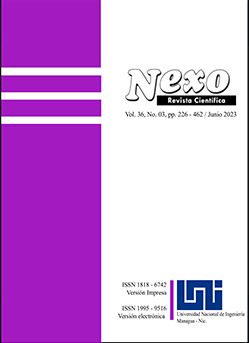Critical assessment of the nortecubana fault
DOI:
https://doi.org/10.5377/nexo.v36i03.16447Keywords:
Caribbean, Cuba, Fault, Hispaniola, SeismotectonicAbstract
The Nortecubana fault is an extensive geological structure (~1.200 km), arched (concave to the south), segmented (into 4 parts) and submarine, in the contemporary plane, seismically active, to the north of Cuba, and which constitutes the northern limit of the megablock. 1) SW-NE -Consolación del Norte, Guane and Pinar faults-; 2) NW-SE -Cubitas, Las Villas and Tuinicú faults-. Historical earthquakes and those of the instrumental period (Mmax 6.2) are associated with it; all interior plate type (North American). The regional category is level 5. Anthropic activity has generated some earthquakes, all of low energy. There are no fatalities associated with fault activity, and it has only generated 2 local tsunamis. It is argued against the incorrect relationship that other authors have assumed with the Northern (North of Hispaniola) and Oriente (South of Eastern Cuba) faults.
Downloads
Downloads
Published
How to Cite
Issue
Section
License
Copyright (c) 2023 Array

This work is licensed under a Creative Commons Attribution 4.0 International License.
The authors who publish in Nexo Scientific Journal agree to the following terms:
- Authors retain the copyright and grant the journal the right of the first publication under the license Creative Commons Attribution License https://creativecommons.org/licenses/by/3.0/, which allows others to share the work with a recognition of the authorship of the work and the initial publication in Nexo Scientific Journal.
- Authors may separately establish additional agreements for the non-exclusive distribution of the version of the work published in the journal (for example, in an institutional repository or a book), with the recognition of the initial publication in Nexo Scientific Journal.
- Authors are allowed and encouraged to disseminate their works electronically (for example, in institutional repositories or in their own website) before and during the submission process, as it can lead to productive exchanges, as well as earlier and greater citation of published works.











